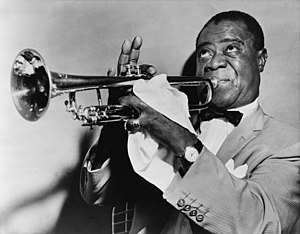When the Saints Go Marching In
Este artigo não cita fontes confiáveis. (Outubro de 2019) |
"When the Saints Go Marching In", um hino gospel estadunidense tão conhecido que muitas vezes é citado apenas como "The Saints", assumiu alguns aspectos de música folclórica. Embora sua origem seja religiosa, hoje em dia as pessoas se acostumaram a ouví-lo interpretado por bandas de jazz.

Letra
editarComo ocorre com muitas composições folclóricas em uso por muito tempo, não há uma versão "oficial" da canção ou de sua letra. A confusão se estende ao próprio título, o qual é frequente e erroneamente trocado por When the Saints Come Marching In, fazendo parecer que os santos citados estão indecisos quanto a ir ou vir. Quanto a própria letra, sua grande simplicidade a torna factível de gerar novas estrofes. Visto que a primeira, segunda e quarta linhas de cada estrofe são exatamente as mesmas, e a terceira é um padrão do início ao fim, a criação de uma linha conveniente em tetrâmetro iâmbico origina uma estrofe inteira.
É quase impossível ouvir-se todas as versões da canção, mas a mais comum é esta:
- We are trav'ling in the footsteps
- Of those who've gone before,
- And we'll all be reunited,
- On a new and sunlit shore,
- Oh, when the saints go marching in
- Oh, when the saints go marching in
- Lord, how I want to be in that number
- When the saints go marching in
- And when the sun refuse to shine
- And when the sun refuse to shine
- Lord, how I want to be in that number
- When the sun refuse to shine
- And when the moon turns red with blood
- And when the moon turns red with blood
- Lord, how I want to be in that number
- When the moon turns red with blood
- Oh, when the trumpet sounds its call
- Oh, when the trumpet sounds its call
- Lord, how I want to be in that number
- When the trumpet sounds its call
- Some say this world of trouble,
- Is the only one we need,
- But I'm waiting for that morning,
- When the new world is revealed.
Não é incomum que as primeiras duas palavras da terceira linha da estrofe em comum ("Lord, how") sejam ditas como "Oh, Lord" ou mesmo "Lord, Lord."
Os arranjos variam consideravelmente. O mais simples é apenas uma repetição interminável do refrão. As estrofes podem se alternar com o refrão, ou inserir a terceira de quatro repetições para criar um formato AABA com a estrofe como ponte.
Uma estrofe comum em versões "apimentadas" de Nova Orleans declara (com variações consideráveis):
- I used to have a playmate
- Who would walk and talk with me
- But since she got religion
- She has turned her back on me.
Alguns arranjos tradicionais também contemplam corais em vez de vozes individuais. É também comum que a canção seja cantada por platéias. Ainda, versões usando "chamado e resposta" são freqüentemente ouvidas, como em:
- Chamado: Oh when the Saints
- Resposta: Oh when the Saints!
Referências
- FULD, James. The Book of World Famous Music, Classical, Popular and Folk
Ligações externas
editar- (em inglês)-Louis Armstrong in Social Context-Texto e vídeo
- (em inglês)-When The Saints Go Marching In-Versão de Louis Armstrong
- (em inglês)-Easybyte - Arranjo para piano de "When the Saints Go Marching In" mais arquivo de som MIDI